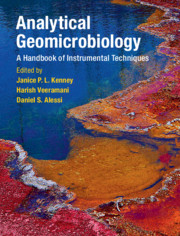Book contents
- Analytical Geomicrobiology A Handbook of Instrumental Techniques
- Analytical Geomicrobiology
- Copyright page
- Contents
- Contributors
- Foreword
- Part I Standard Techniques in Geomicrobiology
- Part II Advanced Analytical Instrumentation
- Part III Imaging Techniques
- Part IV Spectroscopy
- Part V Microbiological Techniques
- 14 Lipid Biomarkers in Geomicrobiology: Analytical Techniques and Applications
- 15 Phylogenetic Techniques in Geomicrobiology
- Index
- References
14 - Lipid Biomarkers in Geomicrobiology: Analytical Techniques and Applications
from Part V - Microbiological Techniques
Published online by Cambridge University Press: 06 July 2019
- Analytical Geomicrobiology A Handbook of Instrumental Techniques
- Analytical Geomicrobiology
- Copyright page
- Contents
- Contributors
- Foreword
- Part I Standard Techniques in Geomicrobiology
- Part II Advanced Analytical Instrumentation
- Part III Imaging Techniques
- Part IV Spectroscopy
- Part V Microbiological Techniques
- 14 Lipid Biomarkers in Geomicrobiology: Analytical Techniques and Applications
- 15 Phylogenetic Techniques in Geomicrobiology
- Index
- References
Summary
Lipid biomarker analysis is a useful tool for characterizing microbial communities in geomicrobiology. Phospholipid fatty acids (PLFA) are major components of microbial membranes, and analysis of these markers provides insight into microbial biomass, community structure, and metabolic processes. This article reviews the methods for extraction, fractionation, derivatization, and quantification of PLFA, as well as the interpretation of PLFA patterns for microbial community analysis in natural environmental systems. The discussion centers on the development, the subsequent modifications, and the advantages and limitations of the methods. Two case studies are given to illustrate the applications of intact phospholipid profiling (IPP) and PLFA in geomicrobiology. The recent developments and future directions of microbial signature lipid analysis are also discussed.
- Type
- Chapter
- Information
- Analytical GeomicrobiologyA Handbook of Instrumental Techniques, pp. 341 - 359Publisher: Cambridge University PressPrint publication year: 2019



